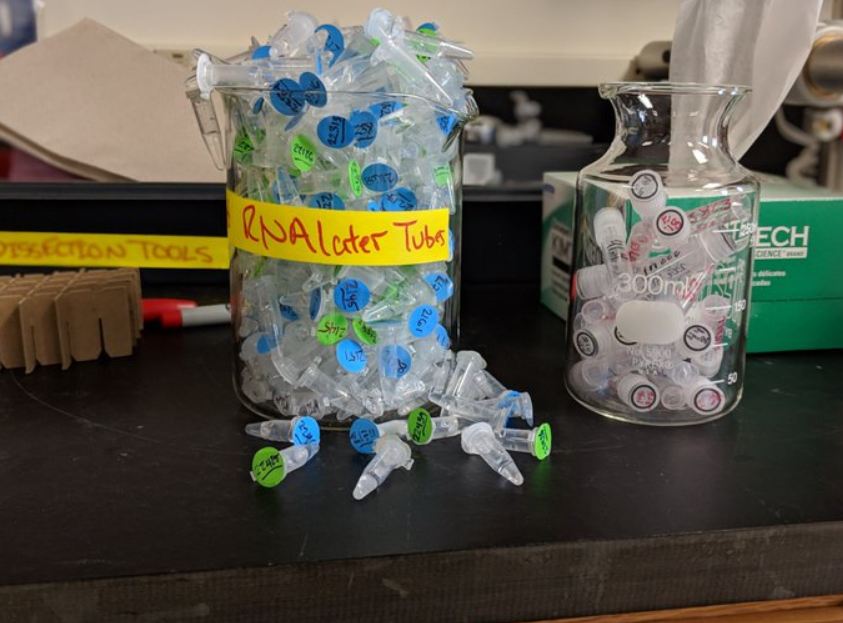

James Fischer developed a passion for climate change and the impacts of climate change on plants as he played in the woods and creeks around his house growing up. He commented “From a very young age I was absolutely fascinated by all things natural. With climate change and human activities having such a negative impact on the natural world that I love, I find it extremely vital to keep studying within this field.” By combining his passion for ecology and climate change with his interest in advising students, James became a mentor for the 2019 MAPS Haskell Environmental Research Studies (HERS) Institute program. The HERS Institute is a workforce development and education initiative supported by the Kansas NSF EPSCoR RII Track-1 Award OIA-1656006: Microbiomes of Aquatic, Plant, and Soil Systems across Kansas (MAPS). Dr. Jay T. Johnson, Professor and Associate Chair of Geography & Atmospheric Science, the Director of The Center for Indigenous Research, Science, and Technology (C-FIRST) at the University of Kansas (KU), and Mr. Cody Marshall, an instructor at Haskell Indian Nations University supervise the program. The program is an 8-week paid summer internship where student interns spend six weeks on the Haskell Indian Nations University campus during June and July. During the internship, students learn about climate change and develop individual research projects.
Initially, James got involved with the HERS program because “It sounded like fun! I also really enjoy reaching out to students as they pursue a career, giving them helpful information, and reassuring them that they are on the right track.” As a mentor, James was responsible for “guiding the students as they went along through the program” as well as providing constructive feedback related to the students’ project, poster, and final presentation. When asked what he learned through his involvement with the HERS institute, he responded, “I picked up a lot of nuances of mentorship. I learned more about how to guide mentees from a supportive role, instead of simply instructing them on what to do. I also learned quite a bit about how to edit student’s papers and posters without taking away their own personal creative voice. Finally, I learned a great deal about the past and current struggles of Native Americans, and how these struggles tie into Native students’ interests and areas of research.” As he described his responsibilities, he mentioned his favorite part of the HERS experience was “Interacting with the interns every day! Due to the students’ unique personalities and spectrum of interests, every day was a new experience, and the interns made each day fun and informative. Breaking out of my very specific niche (plant structures and carbon dioxide) and branching into my interns’ different areas of interest (e.g. climate change and religious beliefs) was a ton of fun.”
A native of Lee’s Summit, MO, James is currently in his fourth year of an Ecology and Evolutionary Biology Ph.D. program at the University of Kansas (KU) working with Dr. Joy K. Ward. Inspired by Aldo Leopold’s book A Sand County Almanac and Robin Wall Kimmerer’s book Braiding Sweetgrass he decided to pursue an undergraduate degree in Ecology and Evolutionary Biology at Missouri State University in Springfield, MO. Once he completed his bachelor’s degree, he immediately started his Ph.D. program James’ research focus is on “the impacts of rising CO2 on small structures of plants.” He described his research as follows, “I specifically look at very small hairs on plants, called “trichomes.” Trichomes defend against herbivores, help to conserve water and reduce leaf temperature, and reflect excess damaging light. Elevated CO2 decreases the number of trichomes across the leaf in some species, so I am interested in the genetics behind this decrease, and the potential impacts on crop and native species. To do this, I grow plants in CO2 concentrations similar to those outside (400 ppm) and similar to the concentration we may hit by the end of this century (800 ppm). I then use next-generation sequencing techniques (like RNA-sequencing) to look at how elevated CO2 changes the RNA pool of the plant, and how this may relate to trichome decreases on the leaf. My goal is to identify the genes that are acting in the mechanism that decreases trichomes under ECO2. I have also designed code to look at the entire leaf, and determine the patterning of trichomes across the surface, allowing me to investigate the very fine impacts of elevated carbon dioxide on the patterning of leaf hairs. Since trichomes play important defensive and physiological roles in wild species and in crop species (e.g. wheat), I believe that my work contributes to protecting native and crop plants from a changing climate.”
In his spare time, James enjoys hiking and using macrophotography to translate the beauty of native flowers into pictures. As for his future plans, he said, “I have my Ph.D. defense scheduled for early May. After I graduate, I have a post-doc at the University of Illinois Urbana-Champaign lined up, working in the lab of Dr. Andrew Leakey. Once I complete my post-doc, I am aiming for a teaching position at an undergraduate university. I also would like to lead a small lab of undergraduate researchers, allowing them to explore plant biology in a relaxed and welcoming environment.”
Workforce Development, Education and Outreach funding for the HERS Institute is provided by the Kansas NSF EPSCoR RII Track-1 Award OIA-1656006 titled: Microbiomes of Aquatic, Plant, and Soil Systems across Kansas. The grant’s workforce development and educational objectives are designed to enhance STEM education in Kansas by supporting activities that will lead to an expanded STEM workforce or prepare a new generation for STEM
